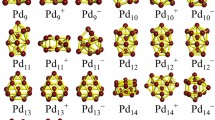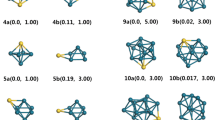Abstract
Density functional theory (DFT) is currently one of the most utilized theoretical approaches to analyze physical and chemical properties of metal clusters, which are of interest in economically important applications such as catalysis. In this respect, the important role of temperature has been scarcely considered mainly because this variable is not part of the DFT model and other theoretical ab initio schemes. In this work, we present an ab initio molecular dynamics study of Pd8 and Pd7Au1 clusters to understand, to a degree, the effect of doping on the structural stability of palladium clusters as a function of temperature. A combined strategy using both empirical potential and DFT calculations is employed to obtain lowest-energy configurations for Pd8 and Pd7Au1 clusters, which are later subject to Born–Oppenheimer molecular dynamics simulations at finite temperatures. The structural stability as a function of temperature is evaluated through an analysis of the total energy dispersion with respect to the average energy of clusters at different thermodynamic states. Results show that the effect of doping Pd cluster with one Au atom gives rise to a decreasing of the structural stability. In the range of temperatures studied, atomic diffusion is not observed for Pd8 cluster, while Pd7Au1 cluster shows Pd-Au dimer diffusion at 300 K toward different faces of the 6-atom Pd octahedron structural motif. Preliminary data suggest that melting transition is about 250 K for this bimetallic cluster.






Similar content being viewed by others
Data availability and material
Data are provided in supplementary zip files including the BOMD trajectories for both Pd8 and Pd7Au1 clusters.
References
Seminario JM, Agapito LA, Yan L, Balbuena PB (2005) Density functional theory study of adsorption of OOH on Pt-based bimetallic clusters alloyed with Cr Co, and Ni. Chem Phys Lett 410:275–281
Larios-Rodríguez EA, Castillón-Barraza FF, Herrera-Urbina R, Santiago U, Posada-Amarillas A (2017) Synthesis of AucorePdshell nanoparticles by a green chemistry method and characterization by HAADFSTEM imaging. J Clust Sci 28:2075–2086
Cristoforetti G, Pitzalis E, Spiniello R, Ishak R, Muniz-Miranda M (2011) Production of palladium nanoparticles by pulsed laser ablation in water and their characterization. J Phys Chem C 115:5073–5083
Thakkar KN, Mhatre SS, Parikh RY (2010) Biological synthesis of metallic nanoparticles. Nanomedicine: NBM 6:257–262
Heck RF, Nolley JP (1972) Palladium-catalyzed vinylic hydrogen substitution reactions with aryl, benzyl, and styryl halides. J Org Chem 37:2320–2322
Mizoroki T, MoriK K, Ozaki A (1971) Arylation of olefin with aryl iodide catalyzed by palladium. Bull Chem Soc Jap 44:581
Miyaura N, Yamada K, Suzuki A (1979) A new stereospecific cross-coupling by the palladium-catalyzed reaction of 1-alkenylboranes with 1-alkenyl or 1-alkynyl halides. Tetrahedron Lett 20:3437–3440
Miyaura N, Suzuki A (1995) Palladium-catalyzed cross-coupling reactions of organoboron compounds. Chem Rev 95:2457–2483
Yin L, Liebscher J (2007) Carbon−carbon coupling reactions catalyzed by heterogeneous palladium catalysts. Chem Rev 107:133–173
Roglans A, Pla-Quintana A, Moreno-Mañas M (2006) Diazonium salts as substrates in palladium-catalyzed cross-coupling. Chem Rev 106:4622–4643
Tseng JY, Cheng HT (2020) Catalytic ethylene oxidation by Cu–Au core–shell nanoclusters: a computational study. Theor Chem Acc 139:57
Saxena R, Saravindakshan SU, Qureshi M, De M (2020) Supported palladium nanoclusters: Morphological modification towards enhancement of catalytic performance using surfactant-assisted metal deposition. Appl Nanosci 10:1793–1809
Klaja O, Szczygieł J, Trawczyński J, Szyja BM (2017) The CO2 dissociation mechanism on the small copper clusters-The influence of geometry. Theor Chem Acc 136:98
Gálvez-González LE, Juárez-Sánchez JO, Pacheco-Contreras R, IGarzón IL, Paz-Borbón LO, Posada-Amarillas A (2018) CO2 adsorption on gas-phase Cu4−xPtx (x = 0−4) clusters: A DFT study. Phys Chem Chem Phys 20: 17071-17080
Gálvez-González LE, Alonso JA, Paz-Borbón LO, Posada-Amarillas A (2019) H2 adsorption on Cu4‑xMx (M = Au, Pt; x = 0−4) clusters: Similarities and differences as predicted by density functional theory. J Phys Chem C 123: 30768−30780
Khirsariya P, Mewada RK (2013) Single step oxidation of methane to methanol-Towards better understanding. Procedia Eng 51:409–415
Petrov AW, Ferri D, Krumeich F, Nachtegaal M, van Bokhoven JA, Kröcher O (2018) Stable complete methane oxidation over palladium based zeolite catalysts. Nature Commun 9:2545
Cheng D, Atanasov IS, Hou M (2011) Influence of the environment on equilibrium properties of Au-Pd clusters. Eur Phys J D 64:37–44
Cristoforetti G, Pitzalis E, Spiniello R (2011) Production of palladium nanoparticles by pulsed laser ablation in water and their characterization. J Phys Chem C 115:5073–5083
Ning X, Zhan L, Wang H, Yu H, Peng F (2018) Deactivation and regeneration of in situ formed bismuth-promoted platinum catalyst for the selective oxidation of glycerol to dihydroxyacetone. New J Chem 42:18837–18843
Luo C, Zhou C, Wu J, Kumar TJD, Balakrishnan N, Forrey RC, Cheng H (2007) First principles study of small palladium cluster growth and isomerization. Int J Quantum Chem 107:1632–1641
Köster A, Geudtner G, Alvarez-Ibarra A, Calaminici P, Casida M, Carmona-Espindola J, Dominguez V, Flores-Moreno R, Gamboa G, Goursot A, Heine T, Ipatov A, de la Lande A, Janetzko F, del Campo J, Mejia-Rodriguez D, Reveles JU, Vasquez-Perez J, Vela A, Zuniga-Gutierrez B, Salahub DR (2018) deMon2k, version 5. The deMon developers, Cinvestav, México City
Pacheco-Contreras R, Juárez-Sánchez JO, Dessens-Félix M, Aguilera-Granja F, Fortunelli A, Posada-Amarillas A (2018) Empirical-potential global minima and DFT local minima of trimetallic AglAumPtn (l + m + n = 13, 19, 33, 38) clusters. Comp Mater Sci 141:30–40
Wales DJ (1997) Doye JPK (1997) Global optimization by basin-hopping and the lowest energy structures of Lennard-Jones clusters containing up to 110 atoms. J Phys Chem A 101:5111–5116
Posada-Amarillas A, Garzón IL (1996) Microstructural analiysis of simulated liquid and amorphous Ni. Phys Rev B 53:8363–8368
Borbón-González DJ, Fortunelli A, Barcaro G, Sementa L, Johnston RL, Posada-Amarillas A (2013) Global minimum Pt13M20 (M = Ag, Au, Cu, Pd) dodecahedral core-shell clusters. J Phys Chem A 117:14261–14266
Guerrero-Jordan J, Cabellos JL, Johnston RL, Posada-Amarillas A (2018) Theoretical investigation of the structures of unsupported 38-atom CuPt clusters. Eur Phys J B 91:123
Cleri F, Rosato V (1993) Tight-binding potentials for transition metals and alloys. Phys Rev B 48:22–33
Ismail R, Johnston RL (2010) Investigation of the structures and chemical ordering of small Pd-Au clusters as a function of composition and potential parameterisation. Phys Chem Chem Phys 12:8607–8619
Heard CJ, Johnston RL, Schön JC (2015) Energy landscape exploration of sub-nanometre copper-silver clusters. ChemPhysChem 16:1461–1469
Luna-Valenzuela A, Alonso, JA, Cabellos, JL, Posada-Amarillas, A (2021) Effects of van der Waals interactions on the structure and stability of Cu8-xPdx (x = 0, 4, 8) cluster isomers. Mater. Today Commun. 26:102024
López-Sosa L, Cruz-Martínez H, Solorza-Feria O, Calaminici P (2019) Nickel and copper doped palladium clusters from a first-principles perspective. Int J Quantum Chem 119:e26013
Yamijala SSRKC, Nava G, Ali ZA, Beretta D, Wong BM (2020) Harnessing plasma environments for ammonia catalysis: Mechanistic insights from experiments and large-scale ab initio molecular dynamics. J Phys Chem Lett 11:10469–10475
Perdew JP, Burke K, Ernzerhof M (1996) Generalized gradient approximation made simple. Phys Rev Lett 77:3865–3868
Dolg M, Cao X (2012) Relativistic pseudopotentials: Their development and scope of applications. Chem Rev 112:403–480
Calaminici P, Janetzko F, Köster AM, Mejia-Olvera R, Zuniga-Gutierrez B (2007) Density functional theory optimized basis sets for gradient corrected functionals: 3d transition metal systems. J Chem Phys 126:044108
Krüger S, Vent S, Nörtemann F, Staufer M, Rösch N (2001) The average bond length in Pd clusters Pdn, n = 4−309: A density-functional case study on the scaling of cluster properties. J Chem Phys 115:2082–2087
Cuny J, Tarrat N, Spiegelman F, Huguenot A, Rapacioli M (2018) Density-functional tight-binding approach for metal clusters, nanoparticles, surfaces and bulk: application to silver and glod. J. Phys.: Condens. Matter 30:303001
Ferrando R (2013) In: Mariscal MM, Oviedo OA, Marcos-Leiva EP (ed) Metal Clusters and Nanoalloys: From Modeling to Applications, Springer, New York
Cheng D, Wang W (2012) Tailoring of Pd–Pt bimetallic clusters with high stability for oxygen reduction reaction. Nanoscale 4:2408–2415
Andersen HC (1980) Molecular dynamics simulations at constant pressure and/or temperature. J Chem Phys 72:2384–2393
Gamboa GU, Calaminici P, Geudtner G, Köster AM (2008) How important are temperature effects for cluster polarizabilities? J Phys Chem A 112:11969–11971
Vásquez-Pérez JM, Martínez GUG, Köster AM, Calaminici P (2009) The discovery of unexpected isomers in sodium heptamers by Born–Oppenheimer molecular dynamics. J Chem Phys 131:124126
Alvarez-Ibarra A, Calaminici P, Goursot A, Gómez-Castro CZ, Grande-Aztatzi R, Mineva T, Salahub DR, Vásquez-Pérez JM, Vela A, Zuniga-Gutierrez B, Köster AM (2015) Chapter 7-First principles computational biochemistry with deMon2k In: Ul-Haq Z, Madura, JD (ed) Frontiers in Computational Chemistry; Bentham Science Publishers: Sharjah, UAE.
de la Lande A, Alvarez-Ibarra A, Hasnaoui K, Cailliez F, Wu X, Mineva T, Cuny J, Calaminici P, López-Sosa L, Geudtner G, Navizet I, Garcia Iriepa C, Salahub DR, Köster AM (2019) Molecular simulations with in-deMon2k QM/MM, a tutorial-review. Molecules 24:1653
Karabacak M, Özçelik S, Güvenç ZB (2004) Dynamics of phase changes and melting of Pd7 clusters. Acta Phys Slovaca 54:233–243
Zanti G, Peeters D (2010) DFT study of bimetallic palladium-gold clusters PdnAum of low nuclearities (n + m ≤ 14). J Phys Chem A 114:10345–10356
Passananti M, Zapadinsky E, Zanca T, Kangasluoma J, Myllys N, Rissanen MP, Kurtén T, Ehn M, Attoui M, Vehkamäki H (2019) How well can we predict cluster fragmentation inside a mass spectrometer? Chem Comm 55:5946–5949
Oderji HY, Ding H (2011) Determination of melting mechanism of Pd24Pt14 nanoalloy by multiple histogram method via molecular dynamics simulations. Chem Phys 388:23–30
Ferrando R, Jellinek J, Johnston RL (2008) Nanoalloys: from theory to applications of alloy clusters and nanoparticles. Chem Rev 108:845–910
Hannemann A, Schön JC, Jansen M, Sibani P (2005) Nonequilibrium dynamics in amorphous Si3B3N7. J Phys Chem B 109:11770–11776
Vásquez-Pérez JM, Calaminici P, Köster AM (2013) Heat capacities from Born-Oppenheimer molecular dynamics simulations: Al27+ and Al28+. Comp Theor Chem 1021:229–232
Acknowledgements
The authors are grateful to Conacyt for funding project No. A1-S-39326. AL-V also acknowledges Conacyt for the award of a Ph.D. scholarship.
Funding
APA is grateful to Consejo Nacional de Ciencia y Tecnología for funding project No. A1-S-39326 AL-V acknowledges Consejo Nacional de Tecnología for the award of a Ph.D. scholarship.
Author information
Authors and Affiliations
Corresponding author
Ethics declarations
Conflict of interest
The authors declare no conflict of interest.
Additional information
Publisher's Note
Springer Nature remains neutral with regard to jurisdictional claims in published maps and institutional affiliations.
Published as part of the special collection of articles “20th deMon Developers Workshop”.
Rights and permissions
About this article
Cite this article
Luna-Valenzuela, A., Cabellos, J.L. & Posada-Amarillas, A. Effect of temperature on the structure of Pd8 and Pd7Au1 clusters: an Ab initio molecular dynamics approach. Theor Chem Acc 140, 86 (2021). https://doi.org/10.1007/s00214-021-02771-8
Received:
Accepted:
Published:
DOI: https://doi.org/10.1007/s00214-021-02771-8




